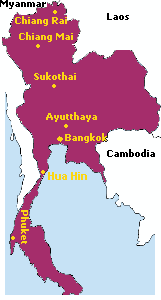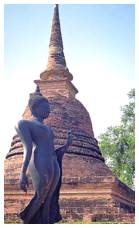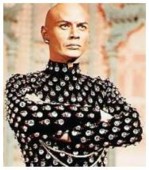|
|
|
|
|
|
|
|
|
|
|
|
|
|
|
|
|
|
|
|
|
|
|
|
|
|
| |
WORLDCOOK'S TRAVELS - THAILAND |
|
|
|
Recipes from Thailand |
|
Travel to Thailand |
|
Travel to other countries |
  The first
inhabitants of Thailand, then called T’ai, came from Southern China.
They crossed the river Mekong in search of more fertile land and settled
in the Chao Prayo basin, at that moment controlled by King Angkor of the Khmer
kingdom. During the twelfth century, his power dwindled and by the middle
of the thirteenth century, the Thai became independent. The first
independent Siamese kingdom Sukothai was established, headed by king
Ramakhamhaeng (Rama of the bold). The first
inhabitants of Thailand, then called T’ai, came from Southern China.
They crossed the river Mekong in search of more fertile land and settled
in the Chao Prayo basin, at that moment controlled by King Angkor of the Khmer
kingdom. During the twelfth century, his power dwindled and by the middle
of the thirteenth century, the Thai became independent. The first
independent Siamese kingdom Sukothai was established, headed by king
Ramakhamhaeng (Rama of the bold).Around the middle of the 14th century, to the south of Sukothai a new kingdom emerged, Ayutthaya, also on the Chao Prayo river, and the city Ayutthaya became the capital and even turned Sukothai into a vassal state later. It flourished for four centuries, until it got burned down by the Burmese. The reason was a fight over a white elephant, which was in the possession of the king of Ayutthaya. This animal was sacred as it is believed to be the final reincarnation of Buddha. The king clung to his elephant but had to pay with his death. After the devastation of the city and its surroundings, general Taksin saw the void and tried his luck. He conquered the whole region and consequently declared himself king, later on he even believed himself to be the equal of Buddha. This was too much for his people, and one of his generals, Chao Praya Chakri, deposed him, became the new king Rama I and founded the new Chakri dynasty, which still exists today. Rama I moved the capital of the country across the river in 1782, to Bangkok. Three main rivers ran close to or through Ayutthaya and therefore it was actively involved in trade, as well with India and China as with the Europeans. This trade had a major influence on Thai food. The Portuguese brought the chili to Thailand around 1500 (they themselves probably brought it from South America), which is now a major ingredient of Thai dishes, making many tourists suffer and sweat, but also enjoy enormously. Just try a hot and sour prawn soup, and you will know what spicy is! | |
|
| |
 At this moment, King Rama IX (Bhumibol Adulyadej) is king of the
country. Rama IV (Mongkut) became famous as the king who hired, in the middle of the
19th century, the famous governess from England Anna Leonowens. Anna wrote
the well known story (the English governess at the Siamese court) about
her life in Siam and her relationship with the king and his children.
Later on, the book was rewritten by Margaret Landon (1943) and a musical,
a television series and a film were based upon her experiences. Not
everybody is sure about the authenticity
of the story and the film was even banned in Thailand in 1999. At this moment, King Rama IX (Bhumibol Adulyadej) is king of the
country. Rama IV (Mongkut) became famous as the king who hired, in the middle of the
19th century, the famous governess from England Anna Leonowens. Anna wrote
the well known story (the English governess at the Siamese court) about
her life in Siam and her relationship with the king and his children.
Later on, the book was rewritten by Margaret Landon (1943) and a musical,
a television series and a film were based upon her experiences. Not
everybody is sure about the authenticity
of the story and the film was even banned in Thailand in 1999. The first five kings of the Chakri dynasty had many wives. Rama IV, who spent 27 years in monastery and only acquired his first wife at the age of 46, had 108 wives and 82 children. The unpromising future as wife 109 probably forced governess Anna to leave for England. The name Siam (meaning gold or brown) was used until 1949, after which it was officially changed to Thailand. The Thai flag looks a little like a compilation of two Dutch flags, one upside down. The flags were everywhere in the Bangkok, a very colorful sight. | |
|
|
|
|
| |
|
| |